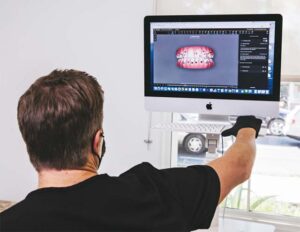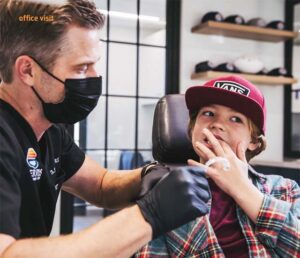Our own Dr. Drew Ferris was featured on the cover of the March 2021 issue of OrthoTown magazine. Check out some of the highlights below or click here to download the full article in PDF format.
Santa Barbara Location Becomes Flagship Office
Dr. Ferris has two orthodontic practices – in Goleta and Santa Barbara – as well as a pediatric dental practice. He recently made the decision to make the Santa Barbara location our flagship office.
“I think the new practice is incredible – state-of-the-art from the ground up. It’s rare to do a new build in a town like Santa Barbara, so it was quite a process and a learning experience.”
“Our space isn’t the only thing that changed; we took this as an opportunity to refresh our brand. We changed our practice’s name, designed a new logo and launched a brand-new website. The thought definitely crossed our mind that with the new location, perhaps this was too much change all at once, but ultimately we decided it was important for us to design a space that fit my personality as a clinician and a person, and this required a shift in the brand, which had been inherited from my late partner.”
 The First Orthodontist in the U.S. to Adopt a 5D Scanner
The First Orthodontist in the U.S. to Adopt a 5D Scanner
Dr. Ferris was the very first orthodontist in the United States to integrate the iTero 5D Scanner in his practice. The leading-edge imaging and diagnostic tool enables Dr. Ferris to identify interproximal caries on every patient he scans.
Why is this important?
“[It] is important because it shows the patients and their parents that as their orthodontist we’re not only there to diagnose and treat crooked teeth; we also care about their overall oral health.”
“Many parents, particularly in California, are sensitive to the idea of exposing their children to radiation via an X-ray. They like knowing that we’re using the most innovative technology to minimize patient exposure. This has helped to further differentiate us from other practices and created a ‘wow factor’ for our patients.”
How the COVID-19 Pandemic Pushed Virtual Care to the Forefront
Dr. Ferris is adamant about keeping abreast of the latest orthodontic technology so that he can continue to provide his patients with an exceptional orthodontic experience and outstanding results. Though he had already begun implementing virtual care into his practice, the pandemic served as a catalyst for Dr. Ferris to embrace the technology even more fully.
“The pandemic has really allowed me to accelerate some of the things I was already doing from a virtual standpoint within our practice. When March 2020 came, I have never been so happy to have such a large share of chair in clear aligner treatment, because those patients were continuing to advance orthodontically while my traditional bracket cases were dead in the water due to not being able to be seen.”
“I already had some virtual communication platforms and techniques in place for starting new patients and monitoring existing ones. When the pandemic hit, I scaled up options like offering virtual new-patient exams to everyone and using SmileSnap on my website, which allows people to submit consultation requests at all hours of the day and night.”
 The Most Common Mistakes Doctors Make with Clear Aligners
The Most Common Mistakes Doctors Make with Clear Aligners
Dr. Ferris is a master faculty member with Invisalign. He is a world-renowned expert in his field and teaches other orthodontists how to achieve the kind of outstanding clinical results his own practice is known for. When it comes to clear aligners, some of the biggest mistakes he sees doctors making stem from a lack of understanding about the technology.
“It’s imperative that clinicians take ownership of their setups, understand attachment design and understand what to prioritize in order to get the movements that are desired. The teeth don’t care what appliance, whether braces or clear aligners, is placing the force on them to cause their movement. There are too many great clinicians saying that aligners can’t do X, Y or Z in certain cases.”
“Although Align Technology has made great strides in its algorithms and its aligner design, it is still just a tool that is only as good as the doctor’s prescription input and ClinCheck design. […] If you’re struggling to make an aligner achieve a specific movement, then it’s important to continue to educate yourself in those areas.”

